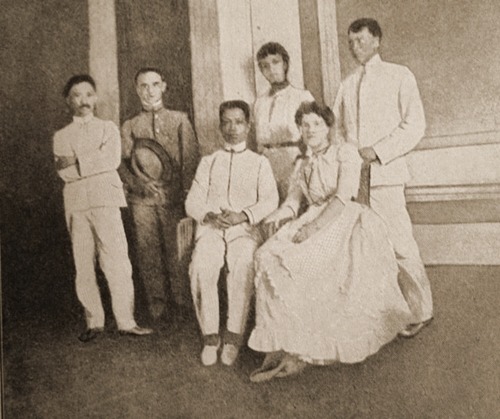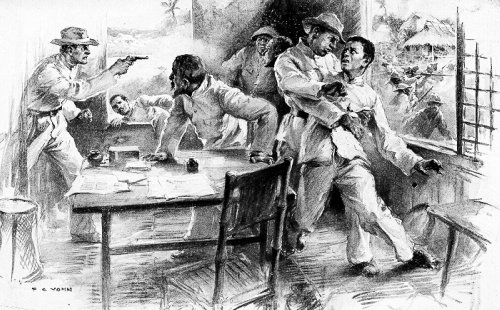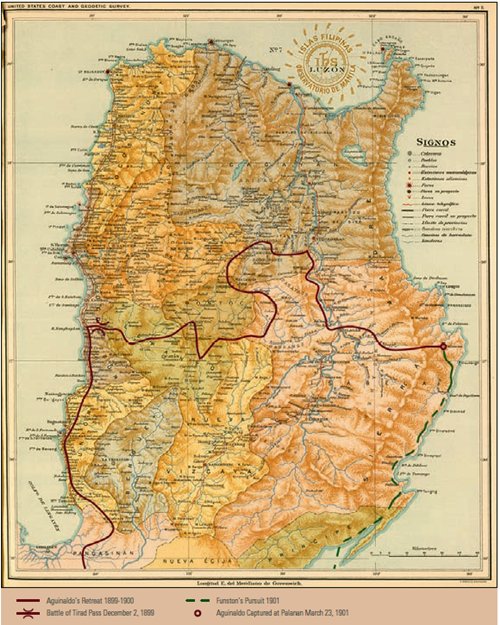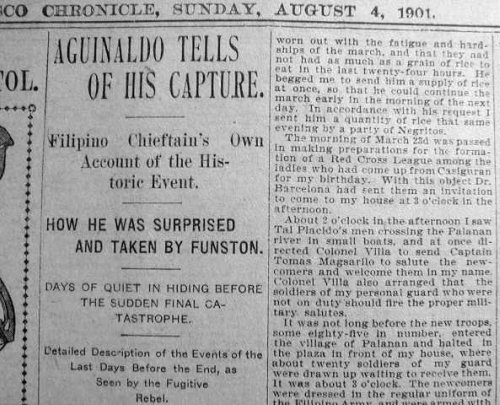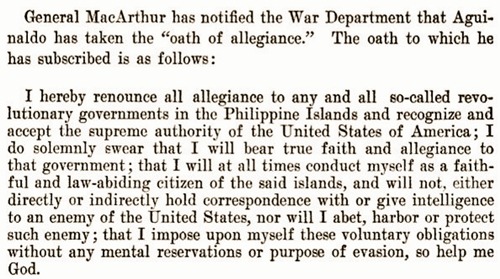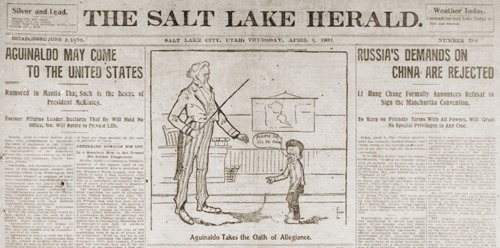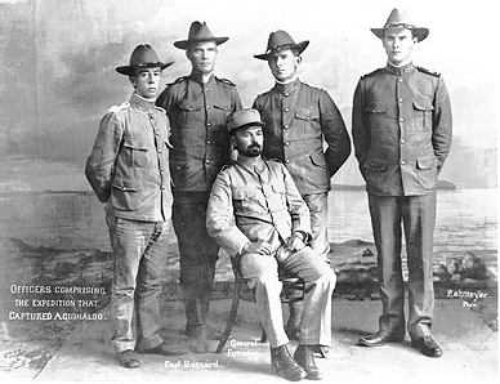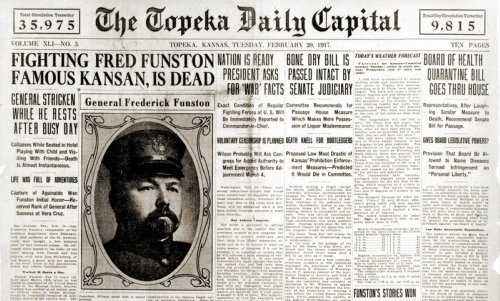Capture of Aguinaldo, March 23, 1901
On Nov. 12, 1899, with his conventional forces shattered, Emilio Aguinaldo ordered a shift to guerilla warfare. Since then, the Americans found it frustrating to crush an enemy who appeared from nowhere, struck at will and slinked back into the shadows. They concluded that the resistance would never be broken until Aquinaldo was killed or captured. However, they did not know his whereabouts.
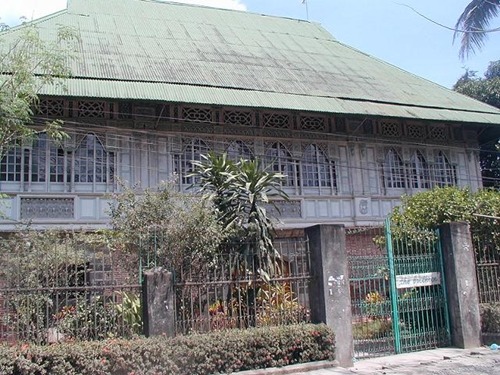
On Feb. 8, 1901, Brig. Gen. Frederick Funston was at San Isidro, Nueva Ecija Province on Luzon Island when six tired and famished guerillas surrendered at Pantabangan town to 1Lt. James D. Taylor, Jr., commander of Company C, 24th Infantry Regiment of U.S. Volunteers. The town mayor, Francisco Villajuan, had convinced the worn-out men to give up. The group was led by Cecilio Segismundo, an Ilocano and Aguinaldo’s messenger, who carried some important dispatches. He was a native of Ilocos Norte Province who had moved to Bulacan Province at age 12; he used to be a member of the municipal police (Guardia Civil Veterana) of Manila under the Spanish. He defected to the Katipunan when the Revolution broke out in August 1896. In 1899, he became a corporal in the Philippine army under Major Nazario Alhambra.
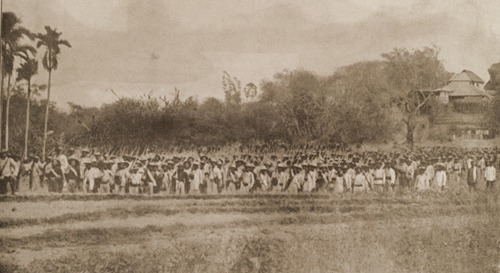
Segismundo pinpointed the village of Palanan, in mountainous Isabela Province, as Aguinaldos headquarters. He told Funston that there was no more than fifty guards at Palanan (Aguinaldo later charged that Segismundo did not talk until after he had been given the water cure twice, but American officers insisted that he gave his cooperation voluntarily).
Some of the coded dispatches carried by Segismundo were signed with the names “Pastor” and “Colon de Magdalo,” which were pseudonyms often used by Aquinaldo. Funston, another American officer, and Lazaro Segovia deciphered the messages. The latter was a former Spanish army officer who had defected to the Philippine army and then switched allegiance to the American side; he understood English, Spanish, and the Tagalog dialect, . The most important message was an order to General Baldomero Aguinaldo instructing him to send some troops to Palanan.

Funston disguised the Macabebes and sent them to Palanan, posing as the men Aquinaldo had requested. Funston and four other American officers, disguised as prisoners of war, accompanied the column. Th
e handpicked Macabebes —78 in number, members of Company D, First Battalion, Macabebe Scouts— spoke Tagalog in addition to their dialect. They turned in their Springfields and were issued 50 Mausers, 18 Remingtons and 10 Krag-Jorgensens, which were the types of rifles used by Aguinaldo’s soldiers. Twenty of them wore the rayadillo uniform of the Philippine army. In addition to Segismundo, Funston included in the column Hilario Tal Placido, Lazaro Segovia, Dionisio Bato, and Gregorio Cadhit. Placido had been a Lieutenant Colonel in the Philippine army and he knew Aquinaldo personally.
Some months previously, Funston had captured General Urbano Lacuna’s seal and official signed correspondence. From this material, two letters were forgedsupposedly from Lacuna to Aguinaldo. One letter contained information as to the progress of the war. The other stated that in accordance with instructions from General Baldomero Aguinaldo, he was sending eighty men to Palanan under the command of Placido, Segovia, and Segismundo.
General Lacuna’s signature was forged by Roman Roque, an expert penman and a former officer in the Philippine army who had surrendered to the Americans; he was employed by the US army as interpreter and clerk. Roque was a native of San Isidro, Nueva Ecija.
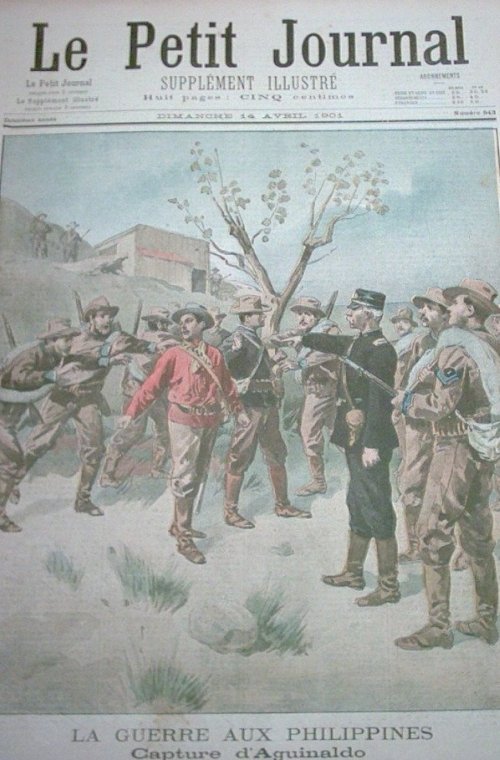
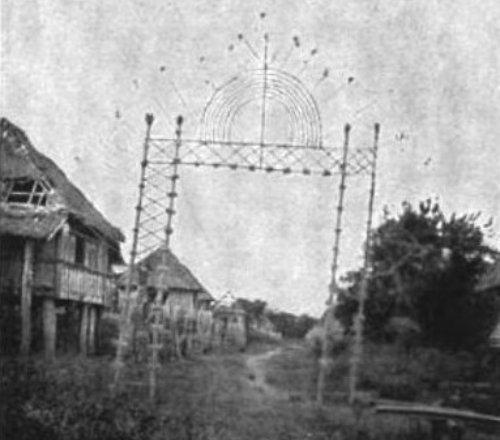
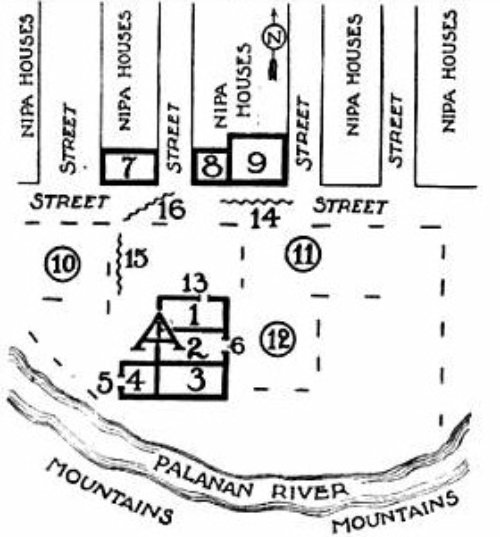
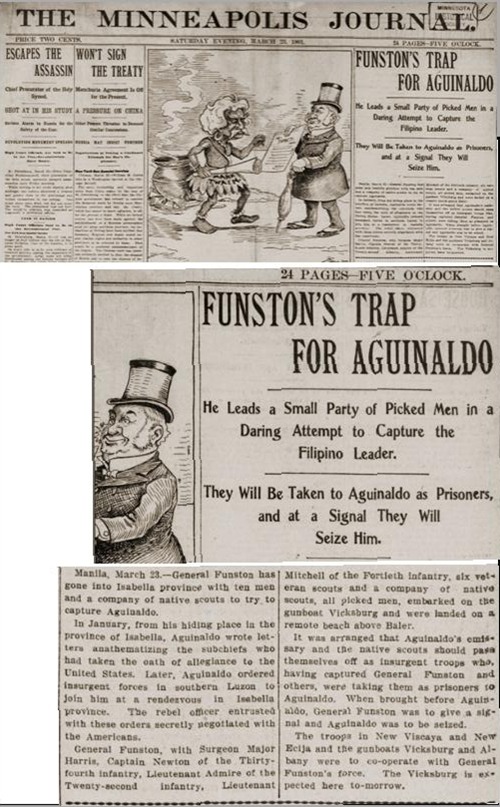
On March 23, the men in disguise reached Palanan, Isabela Province.
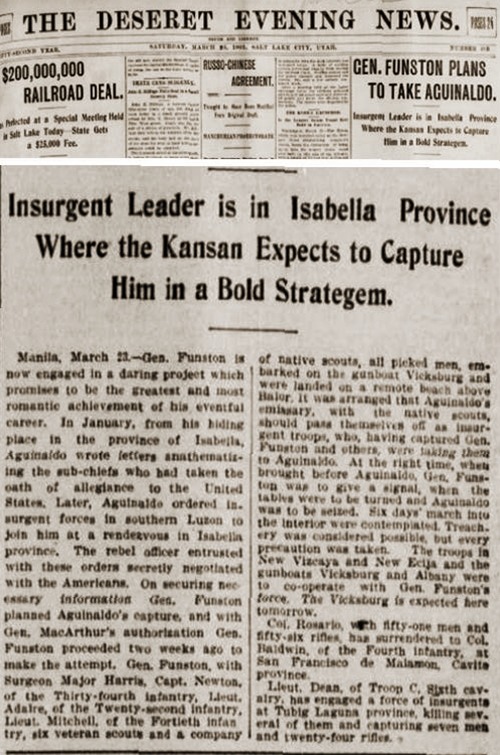
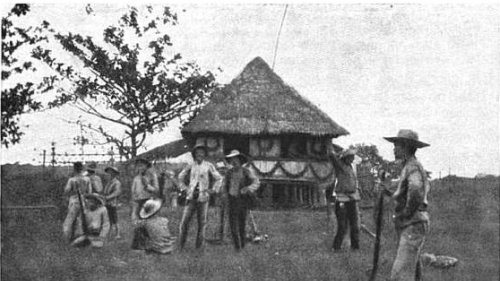
In his memoirs, Aguinaldo describes his capture (paraphrasing mine):
“It was not long before the new troops…entered the village…and halted in the plaza in front of my house, where about twenty soldiers of my guard were drawn up waiting to receive them. It was about three o’clock… The officers, Colonel Tal Placido and Captain Segovia…then came into my house… After talking with Tal Placido and Segovia for fifteen or twenty minutes, I gave orders that the newly arrived men be allowed to fall out and go to rest…Segovia immediately left the house and returned to the place where his men were drawn up…Segovia shouted…an order which we did not hear distinctly…Instantly his men began to shoot…not suspecting any plan against myself, I thought it was a salute with blank cartridges…I ran to the window and cried out several times, ‘Cease firing.’ But seeing that the …bullets from the rifles of the attacking party were directed against me as well as against the soldiers of my guard, I for the first time realized that the newcomers were enemies. I…ran into another room … seized a revolver, intending to defend myself, but Dr. Barcelona threw both arms around me, crying out, ‘Don’t sacrifice yourself. The country needs your life.’ …Colonel Villa ran from the house in an attempt to break through the lines of the enemy and rally our men, but he was shot three times and finally taken prisoner.
“Tal Placido…told us that we were the prisoners of the Americans, who, he said, were on the other side of the river with four hundred American soldiers, and would soon be here…several of Tal Placido’s soldiers came into the house…and surrounded Barcelona and myself. A little later five Americans…came into the room where we were…one of them asked, ‘Which one of you is Aguinaldo?’ As soon as I had been identified by the Americans I was placed, with Dr. Barcelona and Colonel Villa, in one of the rooms of the house…We were then informed that our captors were General Funston, Captains Newton and Hazzard, and Lieutenants Hazzard and Mitchell…”
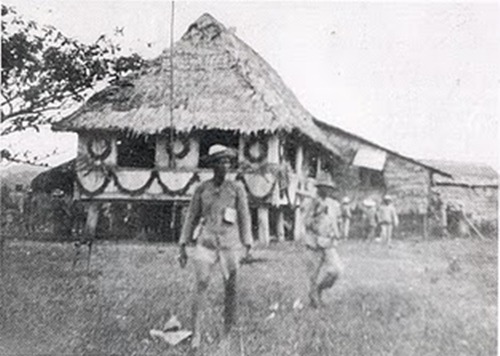
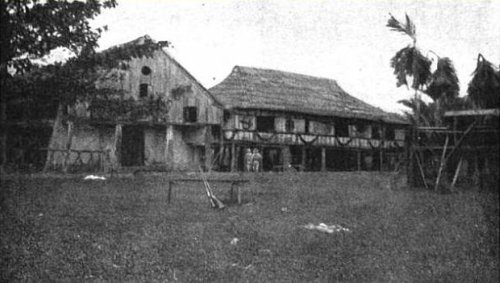
Two of Aguinaldo’s guards were killed. Colonel Simeon Villa, aide to Aguinaldo, suffered superficial gunshot wounds.
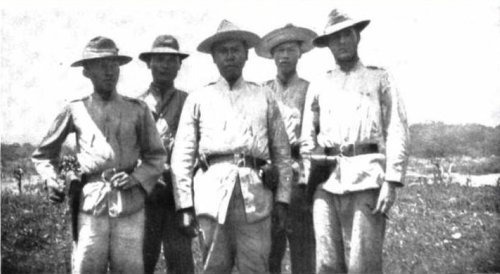
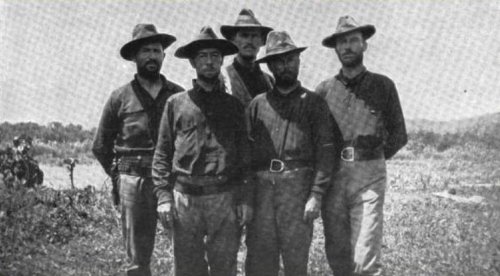
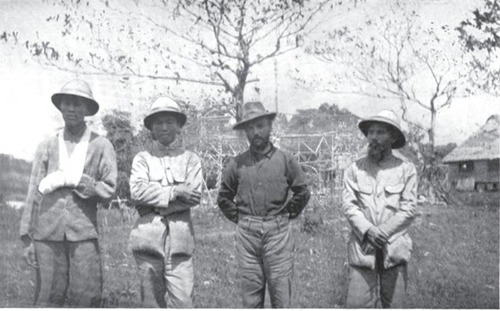
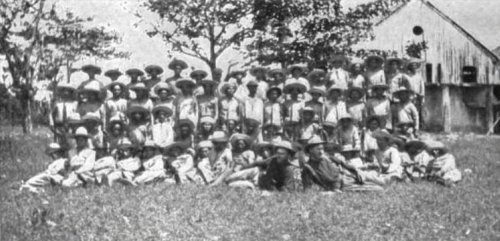
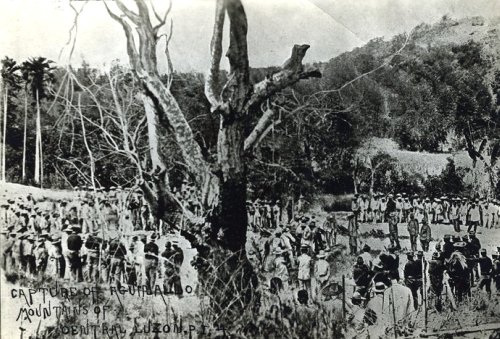
On the morning of March 25, Aguinaldo and three of his men were marched six miles (10 km) to the seashore at Palanan Bay, arriving there at noon.

The Americans made two signal fires and hoisted a white flag. A little later, a steamer rose on the horizon. Within two hours the warship USS Vicksburg was anchored near the beach.
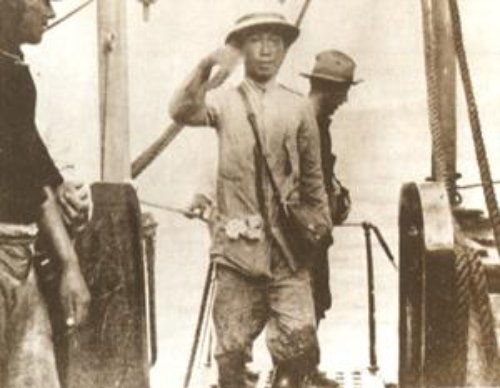
By five o’clock in the afternoon, the prisoners and their captors were all on board, the anchor was hoisted, and the ship made for the open sea bound for Manila.

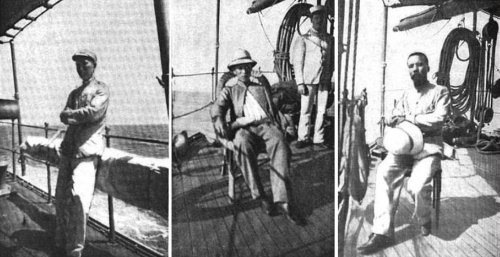
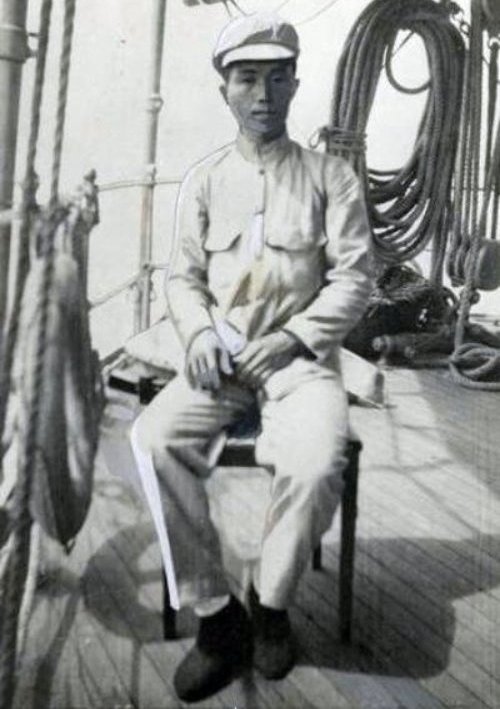
During the trip, Aguinaldo admitted to Funston that he had been completely fooled by the phony dispatches. He later confided that he could “hardly believe myself to be a prisoner” and that he was gripped by a “feeling of disgust and despair for I had failed my people and my motherland.”
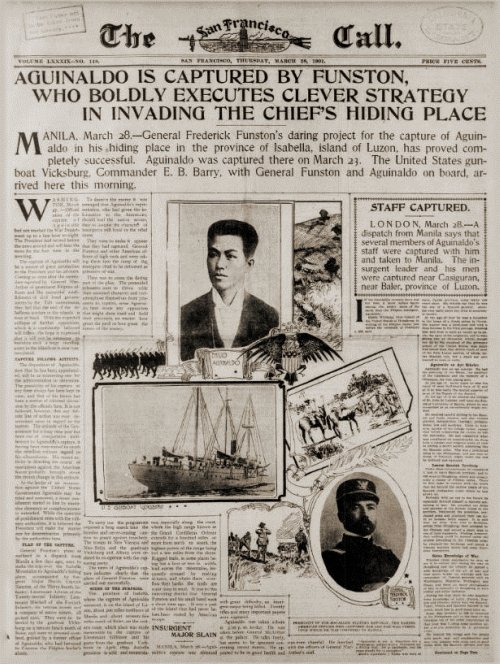
At 2:00 a.m. of March 28, the USS Vicksburg anchored in Manila Bay, with all lights screened, to keep the return of the expedition secret.
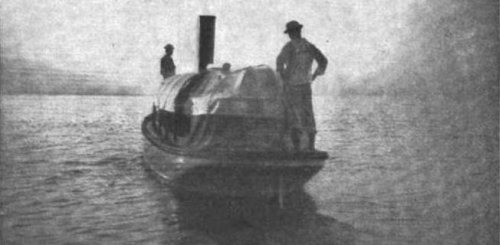
At 6:00 a.m., General Funston and Aguinaldo, accompanied by some officers, boarded one of the launches and left the USS Vicksburg.

They went up the Pasig River to the residence of the Governor-General in Malacaan, where they disembarked. Aguinaldo was presented to Brig. Gen. Arthur C. MacArthur, Jr. as a prisoner of war. He was treated by the Americans more as a guest than as a prisoner.
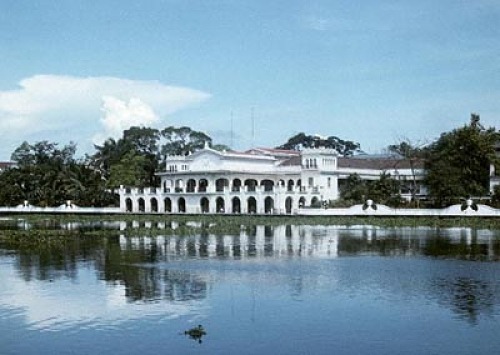
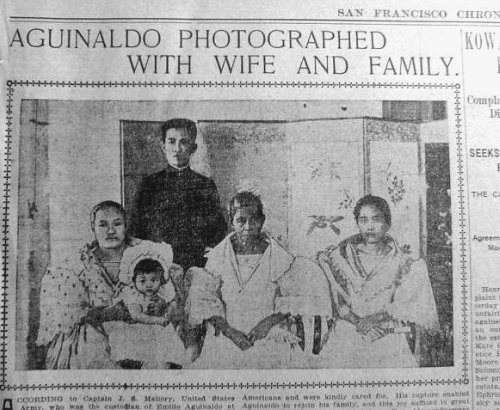
At breakfast, MacArthur promised Aguinaldo that he would immediately send for his family, whom he had not seen for a long time.
Aguinaldo complimented his captors: “At all times since our capture, as well in Palanan as on board the Vicksburg, we have been treated with the highest consideration by our captors, as well as by all the other American officers with whom we have come in contact.”
The administration in Washington called Aguinaldo’s capture “the most important single military event of the year in the Philippines.”
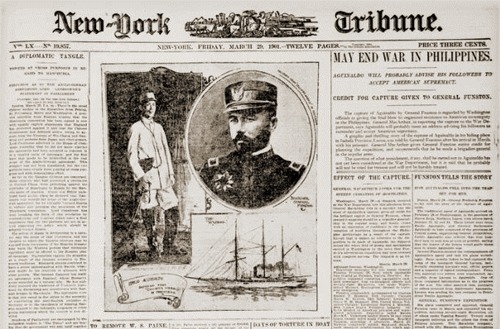
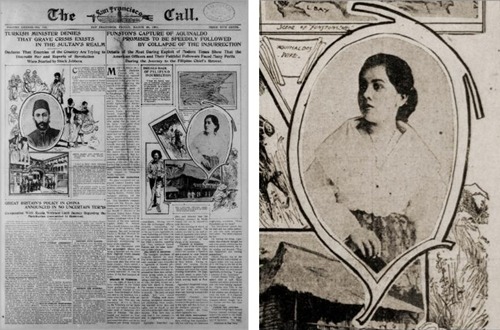
Nine days after his capture, on April 1, Aguinaldo swore allegiance to the United States.
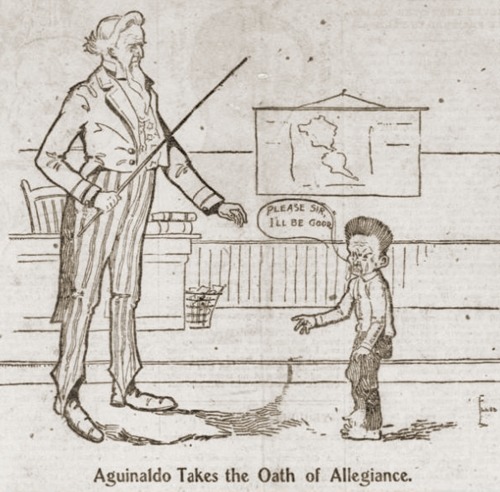
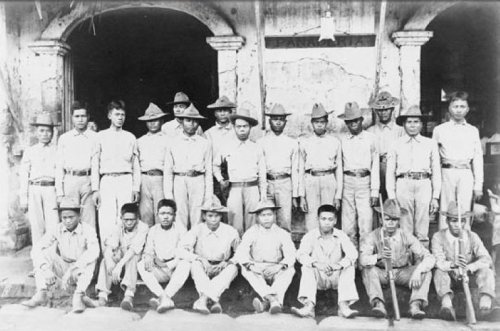
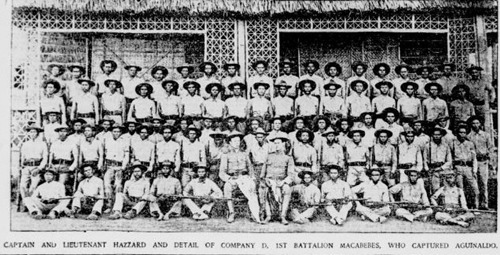
The Macabebes were fierce freedom fighters when they first appeared in written history; they fought the Spanish invaders in 1571. Ironically, it was the Tagalogs (under Lakandula of Tondo and Rajah Soliman of Manila) who eventually welcomed the Spaniards while the Kapampangans (under Tarik Soliman of Macabebe) had to die fighting in the Battle of Bangkusay.
Years later, Macabebes helped the Spaniards drive away the Chinese pirate Limahong, and that was the start of a friendship that would endure to the very last day of the Spanish Period. The Macabebes helped the Spaniards colonize the rest of the archipelago; they also joined in the invasion of the Marianas, Moluccas, Borneo, Formosa, Indochina and the Malay Peninsula.
Without the Macabebes, the Philippines would have been colonized by the Dutch and later by the British, two Protestant nations. This is the reason the feast of the La Naval is celebrated only in two places, Manila and Pampanga.
When the Revolution broke out, the Macabebes sided with the Spaniards even while the rest of Pampanga threw its support for the quest for independence. On June 26, 1898 representatives from all Pampanga towns, except Macabebe, gathered in San Fernando and swore allegiance to Gen. Maximino Hizon (LEFT, image from www.nhi.gov.ph) who was the provincial military governor and representative of General Emilio Aguinaldo. Macabebes in the Spanish military were called “Voluntarios de Macabebe“. Macabebes protected the retreating Spaniards, rescuing friars and the families of the Spanish Army. The Spaniards promised to return and resettle the Macabebes to the Caroline Islands should the revolution succeed.
In retaliation, Antonio Luna’s troops burned the town of Macabebe and executed a large number of its residents (hundreds, according to one unverified account). When the Americans bought and colonized the Philippines, Macabebes enlisted in the US Army by the hundreds. These events fueled the enmity between Kapampangans and Tagalogs, climaxing in the sensational capture of the Tagalog general, Emilio Aguinaldo, President of the Republic of the Philippines. The US President and US Congress, jubilant over Aguinaldo’s capture, authorized the formal inclusion of the Macabebes into the Philippine Scouts, a special unit of the US Army.
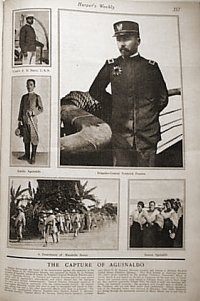
But Funston soon fell under criticism for his methods used to capture Aguinaldo. An editorial in the Boston Post made the following comments:
“When the capture of Aguinaldo by Funston was announced by cable, it was hailed as a great exploit… But, as the details have come to light, contempt and disgust have taken the place of admiration. The American people accepted, though not without some qualms of conscience, the forgery, treachery and disguise with which Funston prepared his expedition.
In 1902, Funston toured the United States to increase public support of the Philippine-American War. He became the focus of controversy by bellicosely promoting total war, enthusiastically endorsing torture and condoning civilian massacres.
In Chicago, he stated, in reaction to the courts-martial of Brig. Gen. Jacob H. Smith and Maj. Littleton Waller for atrocities committed in Samar:
“I personally strung up thirty-five Filipinos without trial, so what was all the fuss over Waller’s ‘dispatching’ a few ‘treacherous savages’? If there had been more Smiths and Wallers, the war would have been over long ago. Impromptu domestic hanging might also hasten the end of the war. For starters, all Americans who had recently petitioned Congress to sue for peace in the Philippines should be dragged out of their homes and lynched.”
General Funston and family at San Francisco, California.
In San Francisco, he suggested that the editor of a noted anti-imperialist paper “ought to be strung up to the nearest lamppost.” At a banquet in the city he called Filipinos “unruly savages” and claimed he had personally killed fifty prisoners without trial.
Captain Edmond Boltwood, an officer under Funston, confirmed that the general had personally administered the water cure to captives, and had told his troops “to take no prisoners.”
Frederick Funston was born on Nov. 10, 1865 in New Carlisle, Ohio. He graduated from High School in 1886 and entered the University of Kansas, but left college without earning a degree. In 1896, he enlisted in the Cuban Revolutionary Army and was made a captain of artillery. Before he became sick with malaria in 1898 and returned home he had risen to the rank of lieutenant colonel. When the Spanish-American war broke out, Funston was appointed a Colonel of the US 20th Kansas Volunteer Infantry Regiment.
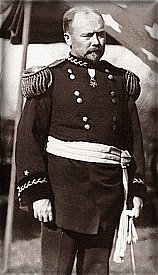
On Feb. 19, 1917, he was having dinner with friends at the St. Anthony Hotel in San Antonio, Texas, close to his headquarters at Fort Sam Houston. He had just finished dinner and was listening to the hotel orchestra play when a moment later he was dead. A heart attack took his life; he was 51-years-old. The people of Texas showed their respect by opening their most sacred shrine, the Alamo, so that he could lie in state there. He was the first person ever so honored. His body was then taken to the San Francisco City Hall Rotunda, where he laid in state for two days.
He was laid to rest at the Presidio (San Francisco National Cemetery) in full dress uniform on a hill overlooking the city.
A San Francisco park was named after General Funston.
Had he not died in early 1917, President Woodrow Wilson would have picked him, not General John J. “Black Jack” Pershing, to command the American forces in World War I.

Aguinaldo’s quarters in the Malacaan Palace grounds, Manila
